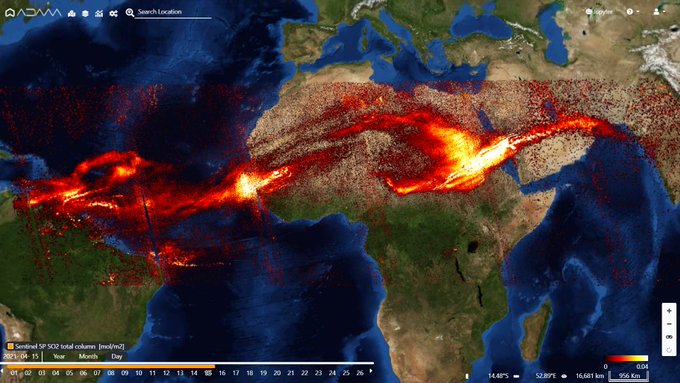Lead Scientist of the La Soufrière Monitoring Unit, Professor Richard Robertson announced that the first time the team was able to successfully measure sulphur dioxide (SO2) flux at La Soufrière, occurred on Thursday, 15th April when Gas Specialist Dr. Thomas Christopher (UWI-SRC/MVO), with the assistance of the SVG Coast Guard, conducted the measurements.
These measurements add to a third element to the unit’s monitoring tools – seismology and ground deformation being the others. The presence of sulphur indicates that fresh magma from a deeper source is present and could trigger continuing eruptions.
Tons of potentially dangerous ash were deposited here in St. Vincent and the Grenadines and as far east as Barbados and now there is confirmation of emissions of sulphur dioxide (SO2).
The UWI SRC noted, “Along with the ash, it (SO2) can be picked up by the planetary winds – in our case the jetstream can be dispersed across the globe.”
The UWI SRC Facebook page went on to show two satellite images from the EU’s Copernicus Sentinel5p Satellite. In the first image, SO2 from the La Soufrière eruption of April 9 was clearly seen moving across the Atlantic. The second image showed the SO2 as it continued its way across Africa, the Arabian Peninsula and Asia.
Additionally, www.earthobservatory.nasa.gov reported on 16th April that a cooling influence on global temperatures could be exerted from volcanic plumes that reach and linger in the stratosphere. Michigan Tech volcanologist Simon Carn stated that, “The current thinking is that a volcano needs to inject at least 5 teragrams of sulfur dioxide into the stratosphere to have measurable climate impacts.”
The site further acknowledged, “After about a week of explosive eruptions, satellite measurements show La Soufrière has delivered about 0.4 – 0.6 teragrams of sulfur dioxide (SO2) to the upper atmosphere. That is already more than any other Caribbean volcano has produced during the satellite era. Those numbers could increase if the eruption continues.”
So, with Sulphur dioxide from the La Soufrière volcano being flung into the stratosphere and reaching across the other side of the globe, what consequence, if any, could there be? Time and further explosive eruptions, if any, will tell.

